7.6: Trade-off between Plasticity and Efficiency
Neuroplasticity varies across brain networks, with each developing on its own timeline (Dow-Edwards et al., 2019). The neural circuitry for basic sensory processes reaches peak plasticity in infancy and stabilizes by early childhood (thereby eliminating the need to relearn basic perception). In contrast, regions governing higher-order executive functions like self-regulation develop later and are highly plastic during adolescence. This developmental pattern illustrates the balance between neuroplasticity for development and stable and efficient processing in mature brains. A trade-off exists: high neuroplasticity and flexibility in a brain network corresponds to low stability and efficiency, and vice versa.
Neural efficiency refers to the brain’s ability to meet task demands with minimal energy expenditure. It also encompasses the ease of communication between different brain regions. The efficiency of information flow across the brain accelerates in adolescence as axons gain myelin insulation, improving electrical transmission speed and reducing energy consumption (Spear, 2013).
Another factor underlying differences in neural efficiency is the formation of synapses. Early research revealed two general phases in synapse development: first a rapid overproduction of synapses, followed by programmed elimination of non-functional synapses to reach adult levels (Huttenlocher, 1979; Huttenlocher & Dabholkar, 1997; Shonkoff & Phillips, 2000). This synapse-formation pattern emerges at different timescales for different brain networks—synapse formation related to sensory processes peaks first, followed by language-related processes, and finally higher-order cognitive functions (Figure 6).
Relevant to neural efficiency, excess synapses during adolescence in frontal lobe regions may render information processing less efficient in those brain regions (Blakemore, 2012). In other words, during adolescence, the brain may require many synapses to carry out cognitive processes. However, as these neuronal connections and functional networks become refined during development, the brain may require fewer synapses to carry out the same cognitive processes. In this way, the brain could shift toward prioritizing the most efficient synapses, which may ultimately lead to more efficient cognitive processing.

The tradeoff between neuroplasticity and stable efficient processing can be illustrated by recent research. In one study, a drug (valproate) reopened a critical period for a sensory task. When given this drug, adults could better learn to identify the names of musical pitches (termed “absolute pitch”), a skill that typically can only be acquired early in life (Gervain et al., 2013). This discovery holds exciting potential for increasing adult plasticity to learn new skills and rewire undesired established neural pathways (e.g., for treating addiction or psychiatric disorders). However, caution is needed when tampering with plasticity in the brain. For example, critical periods have evolved for a reason, and reopening critical periods might destabilize long-established neural circuits for efficiently processing things like how to see the world or understand language.
Finally, psychedelic drugs have shown potential to treat addiction and some psychological disorders. A recent study suggests that psychedelic drugs can reopen critical periods and increase neuroplasticity in mice (Nardou et al., 2023). Additionally, psychedelics may induce cellular and molecular adaptations related to neuroplasticity and these may support the clinical effects of psychedelics in humans (de Vos et al., 2021; Calder & Hassler, 2023). While more work on psychedelics and neuroplasticity is needed, the possibility of inducing neuroplasticity could lead to rich learning and brain restructuring, but it also underscores the importance of working with a trained professional when the brain is in a more malleable state in order to not destabilize desired neural circuits.
Media Attributions
- Syanpse Formation Across Development © National Library of Medicine is licensed under a CC BY-NC-SA (Attribution NonCommercial ShareAlike) license
The process in which the brain spends fewer energy resources to carry out specific brain functions and subsequent behavior. Typically indicative of a matured functional brain network.

